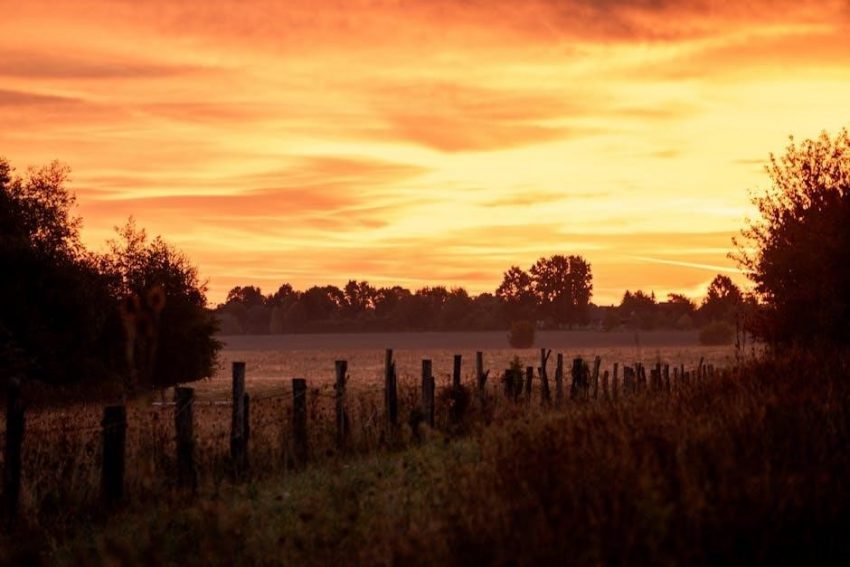Michigan’s diverse landscape hosts over 100 tree species, ranging from deciduous giants like oaks and maples to coniferous pines and spruces. Field guides, such as Michigan Flora by E.G. Voss, provide detailed descriptions of native and naturalized trees, emphasizing leaf structure, bark patterns, and seasonal variations. These resources enable enthusiasts to identify species accurately, making tree spotting an enjoyable and educational experience across the state’s forests and urban areas.
Overview of Michigan’s Forest Ecosystems
Michigan’s forests are a mosaic of ecosystems, including northern hardwoods, conifers, and mixed forests, supporting a wide variety of tree species. Wetlands and riverbanks host unique species like black willow and red maple, while urban areas feature oaks and maples. The state’s forests are vital for biodiversity, providing habitats for wildlife and contributing to ecological balance. These ecosystems are shaped by climate, soil, and hydrology, creating diverse landscapes that sustain both native and naturalized tree species. Understanding these ecosystems is essential for conservation and sustainable forestry practices in Michigan.
Importance of Tree Identification
Tree identification is crucial for understanding Michigan’s ecosystems and managing its natural resources effectively. Accurate identification helps in conservation efforts, such as protecting endangered species and combating invasive trees. It also aids in sustainable forestry practices, ensuring healthy tree populations for future generations. Additionally, identifying trees fosters environmental awareness and education, allowing individuals to appreciate the diversity of Michigan’s flora. Field guides like Stan Tekiela’s Trees of Michigan provide essential tools for enthusiasts and professionals alike, making tree identification accessible and informative for all skill levels.
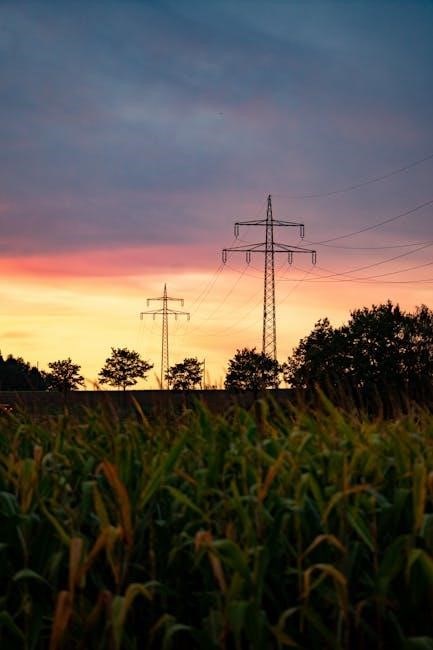
Key Characteristics for Tree Identification
Leaf structure, bark patterns, flowers, fruits, and seasonal changes are essential for identifying Michigan’s trees. These characteristics provide clear clues for accurate identification and differentiation between species.
Leaf Structure and Types
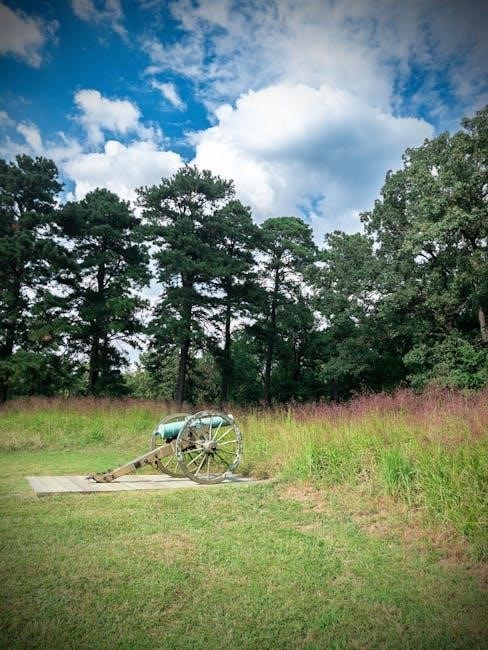
Leaves are a critical feature for identifying Michigan’s trees, varying in shape, arrangement, and venation. Simple leaves, like those on elms, are single-bladed, while compound leaves, such as walnuts and hickories, consist of multiple leaflets. Oaks often display lobed leaves, while maples have palmate or deeply lobed shapes. Leaf margins can be toothed, smooth, or wavy, and venation patterns, like the prominent midrib in ashes, aid identification. Trees like birches and cherries exhibit alternate leaf arrangements, while others, such as dogwoods, have opposite leaves. These characteristics, along with seasonal color changes, make leaf analysis a powerful tool for accurate tree identification.
Bark Patterns and textures
Bark Patterns and Textures
Michigan’s tree species exhibit diverse bark patterns and textures, aiding identification. Oaks and pines often display rugged, furrowed bark, while birches and sycamores have smooth or peeling bark. Maples may show shallow furrows or scales, and ashes often feature diamond-shaped patterns. Elms and hickories tend to have fissured bark, while walnuts may have deep grooves. Seasonal changes can alter bark appearance, such as the reddish hue of young cherry trees. Observing these details helps distinguish species, especially in winter when leaves are absent. Bark textures and patterns are reliable identifiers, complementing leaf and twig analysis for accurate tree recognition.
Flower and Fruit Identification
Identifying Michigan’s trees by their flowers and fruits provides critical clues. Oaks produce catkins and acorns, while maples yield samaras and pines form cones. Cherries and plums display showy flowers followed by edible drupes. Ash trees develop samaras, and walnuts produce large, rounded nuts. Elms and hickories have distinct flower clusters and nut shapes. Seasonal timing is key, as flowers bloom in spring and fruits ripen in late summer or fall. Observing size, color, and structure of these features helps differentiate species, especially when leaves are absent or less distinctive. This method complements other identification techniques for accurate tree recognition.
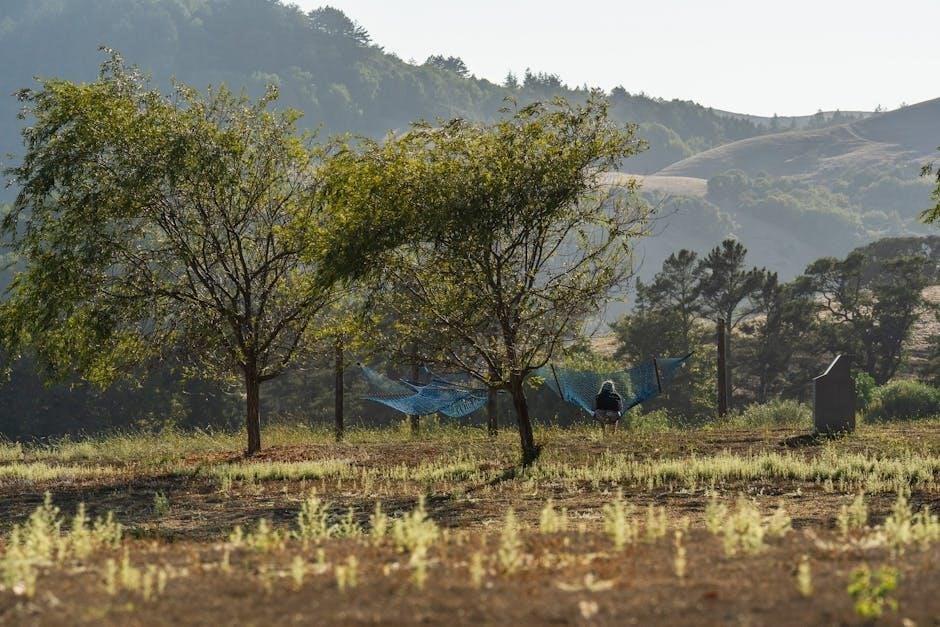
Deciduous Trees of Michigan
Deciduous trees dominate Michigan’s landscapes, with species like oaks, maples, and ashes adapting to the state’s seasonal climate. They shed leaves annually, creating vibrant fall colors.
Oaks (Quercus spp.)
Oaks are among Michigan’s most iconic deciduous trees, with over 20 native species. Known for their lobed or deeply toothed leaves, oaks produce acorns, a vital food source for wildlife. Species like white oak, red oak, and black oak thrive in Michigan’s diverse habitats, from forests to urban areas. Oaks are long-lived, with some trees aging over 300 years. Their sturdy wood and broad canopies make them ecologically and economically significant. Identification often relies on leaf shape, acorn size, and bark patterns, which vary between species.
Maples (Acer spp.)
Maples are highly recognizable trees in Michigan, known for their vibrant fall colors and distinctive leaf shapes. Species like sugar maple (Acer saccharum) and red maple (Acer rubrum) are common statewide. Sugar maple is iconic for its role in syrup production, while red maple adapts well to wetland habitats. Maples often feature three to five-lobed leaves, with colors ranging from deep green in summer to fiery oranges and reds in autumn. Their samaras, or winged seeds, are another key identifier. These trees thrive in diverse environments, making them a cornerstone of Michigan’s landscapes.
Elms (Ulmus spp.)
Elms are deciduous trees widely distributed across Michigan, with species like the American elm (Ulmus americana) and slippery elm (Ulmus rubra) being prominent. Known for their vase-shaped crowns and tall, upright growth, elms thrive in urban areas, floodplains, and forests. Their leaves are alternate, simple, and doubly serrated, typically dark green on the upper surface with lighter undersides. Elms produce small, inconspicuous flowers in early spring, followed by winged seeds. Historically significant for shade and timber, elms are also vital for wildlife, providing food and habitat. Their adaptability makes them a common sight in Michigan’s diverse landscapes.
Ash Trees (Fraxinus spp.)
Ash trees (Fraxinus spp.) are common in Michigan, with species like black ash (F. nigra), white ash (F. americana), and green ash (F. pennsylvanica). Known for their compound leaves with 5-9 leaflets, ash trees thrive in wetlands, forests, and urban areas. Their bark is smooth when young but becomes fissured with age. Ash trees produce small, winged seeds (samaras) and are valued for their wood and shade. However, they face threats from the invasive emerald ash borer, which has significantly impacted their populations across the state. Conservation efforts are underway to protect these ecologically important trees.
Walnut and Hickory (Juglans and Carya spp.)
Walnut (Juglans spp.) and hickory (Carya spp.) are valuable timber trees in Michigan. Black walnut (J. nigra) is highly prized for its dark wood and edible nuts. Shagbark hickory (C. ovata) is known for its distinctive peeling bark. Both genera thrive in well-drained forests and woodlands. Their compound leaves, with 15-23 leaflets, are a key identifier. Walnut trees grow tall with broad canopies, while hickories often have a more spreading habit. These species are ecologically important, supporting wildlife and maintaining forest diversity. Their nuts are a vital food source for many animals, making them a cornerstone of Michigan’s ecosystems.
Coniferous Trees of Michigan
Michigan’s coniferous trees include pines, spruces, firs, and cedars. These evergreens dominate northern forests, providing year-round greenery and vital wildlife habitats. They adapt to various soil conditions.
Pines (Pinus spp;)
Pines are among Michigan’s most iconic conifers, with species like white pine and red pine thriving in the state’s forests. Known for their long, needle-like leaves grouped in bundles, pines are easily identifiable. White pines often grow tall, with broad, irregular crowns, while red pines are shorter and more compact. Both species prefer well-drained soils and full sun. Pines are ecologically vital, providing habitat for wildlife and contributing to Michigan’s timber industry. Their cones vary in size and shape, with white pine cones being larger and red pine cones smaller and more rounded.
Spruces (Picea spp.)
Spruces are common in Michigan’s forests, with species like black spruce and white spruce prevalent. They are distinguished by their sharp, four-sided needles and pendant cones. Black spruce prefers wetlands, while white spruce thrives in well-drained areas. Both are adapted to cool climates and play a key role in Michigan’s ecosystems. Spruces are valued for their timber and as ornamental trees. Their evergreen foliage provides year-round habitat for wildlife. Identification often relies on needle texture and cone shape, with white spruce having larger, cylindrical cones compared to black spruce’s smaller, upright ones.
Firs (Abies spp.)
Firs are evergreen trees in Michigan, with balsam fir being the most common. They thrive in cool, moist environments, often found in northern regions. Firs are identified by their soft, flattened needles with two white bands on the underside. Cones are upright, cylindrical, and disintegrate at maturity. Balsam fir is highly aromatic, with resin blisters on bark. These trees are vital for wildlife habitat and are popular Christmas trees. Firs are distinguished from spruces by their smoother bark and from pines by their needle arrangement and cone structure, making them a unique part of Michigan’s coniferous landscape.
Cedar and Cypress (Cedrus and Taxodium spp.)
Cedar and cypress trees in Michigan are primarily ornamental species, with Eastern Red Cedar (Juniperus virginiana) and Bald Cypress (Taxodium distichum) being notable examples. Cedars are known for their aromatic, scale-like foliage and columnar growth. Bald Cypress thrives in wetlands, producing distinctive “knees” for oxygen in flooded soils. Both species are valued for their durability and resistance to rot. Cedars are often used as windbreaks, while cypresses add unique beauty to landscapes. These trees are not native to all regions of Michigan but are widely cultivated for their adaptability and striking appearance.
Hemlock (Tsuga spp.)
Eastern Hemlock (Tsuga canadensis) is a common coniferous tree in Michigan’s forests. It is known for its short, flat needles with two white bands on the underside and small, pendulous cones. Hemlocks thrive in shaded, moist environments and are often found along streams or in dense woodlands. They are slow-growing and shade-tolerant, making them a key component of Michigan’s forest ecosystems; Hemlocks are ecologically important, providing habitat for wildlife like the Hemlock Woolly Adelgid, an invasive species affecting their populations. Conservation efforts are essential to protect this vital tree species in Michigan’s landscapes.
Native vs. Invasive Tree Species
Michigan’s forests feature a mix of native and invasive tree species; Native trees, like oaks and maples, naturally occur in the region, while invasive species, such as the Eurasian tree of heaven, disrupt ecosystems and outcompete natives. Invasives often spread quickly, harming biodiversity and forest health. Understanding and managing these species is crucial for conservation and maintaining Michigan’s ecological balance.
Native Tree Species of Michigan
Michigan is home to a diverse range of native tree species, including oaks, maples, pines, and cherries. These species have evolved alongside local wildlife, forming vital ecological relationships. Native trees like the sugar maple and white pine are iconic, supporting pollinators and wildlife. They are well-adapted to Michigan’s climate, ensuring resilience against natural stressors. Preserving these species is essential for maintaining healthy ecosystems and biodiversity. Native trees also play a key role in Michigan’s economy, contributing to forestry and tourism. Their sustainability is a priority for environmental conservation efforts across the state.
Invasive Tree Species and Their Impact
Michigan faces threats from invasive tree species like the Tree-of-Heaven (Ailanthus altissima) and Autumn Olive (Elaeagnus umbellata). These non-native species outcompete native trees, disrupting ecosystems and reducing biodiversity. Invasive trees often spread rapidly, forming dense stands that shade out native plants and harm wildlife habitats. They can also degrade soil quality and alter water cycles. Managing these species is crucial to protect Michigan’s forests and wetlands. Early detection and eradication efforts are essential to mitigate their long-term environmental and economic impacts on the state’s natural resources.
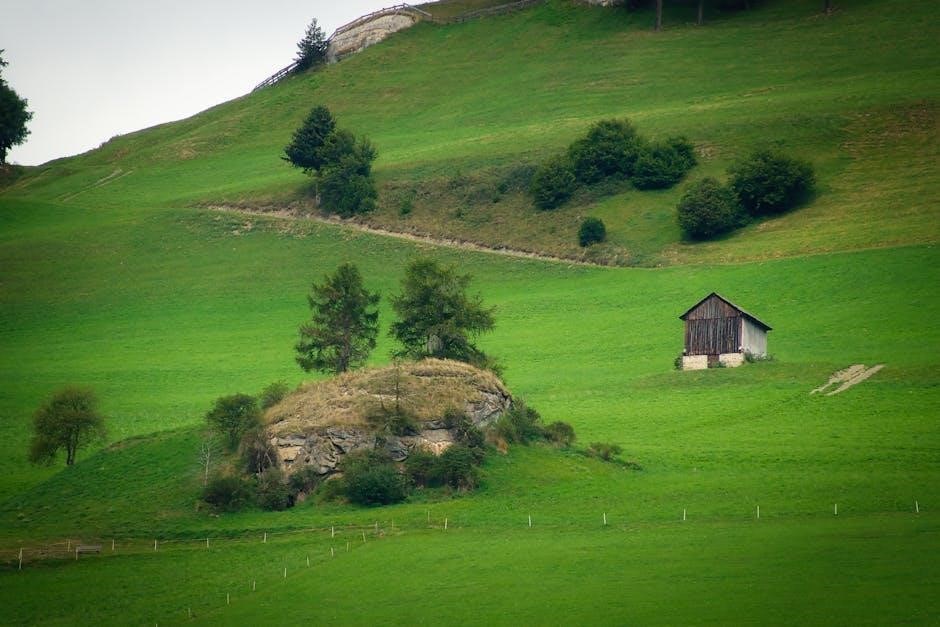
Tree Identification by Season
Identifying trees by season involves observing seasonal traits like spring flowers, summer leaves, autumn colors, and winter bark, aiding year-round recognition of Michigan’s diverse tree species.
Spring Identification (Flowers and New Growth)
In spring, Michigan trees display unique flowers and new growth, aiding identification. Deciduous trees like oaks and maples show buds swelling and leaves unfurling. Flower types vary: catkins on birches, showy blossoms on cherries, and inconspicuous flowers on pines. Colors range from yellow to purple, depending on species. New leaves often emerge with distinctive shapes and colors, providing clues. Observing these traits helps distinguish species, especially when combined with bark and twig features. Spring’s vibrant transformations offer a prime opportunity to study and identify Michigan’s diverse tree species accurately.
Summer Identification (Leaves and Shape)
Summer offers prime opportunities to identify Michigan trees by their leaves and overall shape. Leaves reach full size, revealing distinct shapes, margins, and venation patterns. Simple leaves, like those on oaks, contrast with compound leaves found on walnuts and hickories. Leaf arrangements—alternate, opposite, or whorled—provide additional clues. Tree silhouettes, such as the broad canopy of maples or the columnar form of firs, also aid identification. Observing these traits helps distinguish species, as summer foliage often showcases a tree’s most characteristic features.
Autumn Identification (Color and Fruits)
Autumn transforms Michigan trees with vibrant foliage and fruit production, aiding identification. Trees like sugar maples display bright red or orange, while oaks turn deep red or brown. Fruit types vary widely: oaks produce acorns, maples yield winged samaras, and elms bear small seed pods. Ash trees develop long, narrow keys, and hickories produce edible nuts in husks. These seasonal traits provide clear clues for distinguishing species, as color patterns and fruit characteristics are often unique to specific trees, making autumn a prime time for accurate identification.
Winter Identification (Bark and Twigs)
In winter, Michigan trees are identified by bark patterns, twig shapes, and bud structures. Oaks display rugged, deeply furrowed bark, while maples have smoother, gray bark with vertical furrows. Ash trees often show a distinctive diamond-shaped pattern, and beeches retain smooth, bluish-gray bark. Twigs vary in color and texture: birch twigs are slender and brown, while cherry twigs are reddish with lenticels. Buds differ in size and arrangement, aiding identification. These features remain consistent, offering reliable clues for distinguishing species when leaves are absent, making winter a unique season for observing tree characteristics.
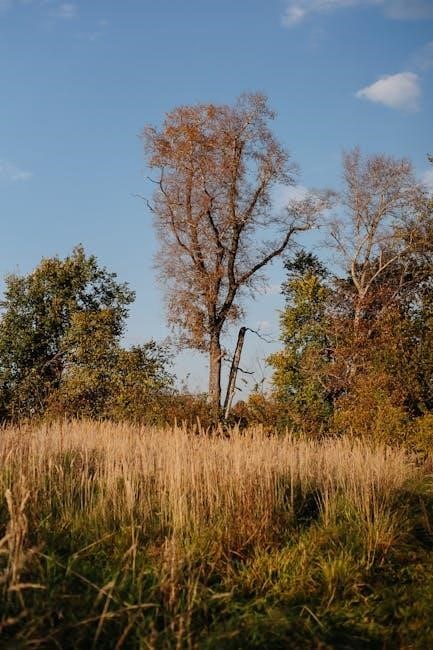
Tools and Resources for Tree Identification
Field guides, online databases, and mobile apps are essential tools for identifying Michigan’s trees, offering detailed descriptions, images, and interactive features to aid in accurate identification.
Field Guides and Manuals
Field guides and manuals are indispensable for identifying Michigan’s tree species, providing detailed descriptions, high-quality images, and diagrams. Popular guides like Trees of Michigan by Burton V. Barnes offer comprehensive information on native and invasive species. These manuals often include keys for identifying trees based on leaf structure, bark patterns, and fruit characteristics. They cater to both beginners and experts, making them versatile tools for fieldwork. Many guides focus specifically on Michigan’s ecosystems, ensuring relevance and accuracy for regional tree identification. They are portable, durable, and essential for anyone exploring the state’s diverse arboreal landscape.
Online Identification Tools
Online identification tools provide instant access to tree species information, enhancing the field guide experience. Platforms like Leafsnap and iNaturalist use visual recognition technology to identify trees based on photos of leaves, bark, or flowers. These tools offer detailed databases of Michigan’s native and invasive species, complete with images and descriptions. They are particularly useful for beginners, as they simplify the identification process. Many online tools are free, accessible via smartphones, and regularly updated with new data. They also allow users to share observations and learn from a community of experts and enthusiasts, making tree identification more interactive and educational.
Mobile Apps for Tree Identification
Mobile apps have revolutionized tree identification, offering portable solutions for fieldwork. Apps like PlantSnap and Tree Identification by Picture enable users to upload photos of leaves, bark, or flowers for instant species recognition. These apps often include extensive databases of Michigan’s native and invasive trees, complete with images and range maps. Many apps also provide offline access, making them useful in remote areas with limited internet connectivity. They are user-friendly, allowing quick identifications and enhancing the field guide experience with modern technology. These tools are invaluable for both professionals and casual nature enthusiasts exploring Michigan’s forests and landscapes.
Common Trees in Michigan’s Landscapes
Michigan’s landscapes feature a diverse range of tree species, with oaks, maples, pines, and birches being among the most common. These trees thrive across various habitats, including forests and wetlands.
Trees Found in Wetlands and Riverbanks
Michigan’s wetlands and riverbanks are home to trees adapted to moist environments. Species like Black Willow, River Birch, and Silver Maple thrive in these areas due to their tolerance of saturated soils.
Black Willow, with its slender branches, often grows near waterways, while River Birch prefers riverbanks and wet meadows. Silver Maple, known for its broad leaves, commonly lines riversides, stabilizing banks with its extensive root system. These trees play a vital role in maintaining ecosystem balance, providing habitat for aquatic wildlife and preventing erosion along watercourses. Their unique adaptations make them well-suited to Michigan’s diverse wetland and riparian zones.
Trees of Michigan’s Urban Areas
Michigan’s urban areas feature a variety of trees that thrive in cultivated environments. Species like Norway Maple, Green Ash, and Littleleaf Linden are common due to their adaptability to city conditions.
These trees are often planted for their ornamental value and ability to tolerate urban stresses, such as pollution and compacted soil. Red Maple and Honeylocust are also prevalent, providing shade and aesthetic appeal. Urban trees play a crucial role in improving air quality, mitigating heat islands, and enhancing community beauty. They are frequently maintained in parks, boulevards, and residential landscapes across Michigan’s cities.
Trees in Michigan’s Forests and Woodlands
Michigan’s forests and woodlands are dominated by species like oak, maple, and pine, which thrive in the state’s temperate climate. Hardwood forests often feature sugar maple, red maple, and yellow birch, while coniferous stands include eastern white pine and hemlock. Mixed forests combine both types, fostering biodiversity. These ecosystems cover much of Michigan’s landscape, providing habitat for wildlife and supporting the state’s forestry industry. Forest composition varies by region, with northern areas favoring evergreens and southern regions hosting more deciduous species, reflecting differences in soil and moisture conditions.

Challenges in Tree Identification
Challenges in tree identification include similar species, seasonal changes, and environmental damage. Accurate recognition requires careful observation of leaves, bark, and growth patterns to avoid misidentification.
Misidentification of Similar Species
Misidentification occurs when species share similar traits, such as leaf shape or bark patterns. For example, red and sugar maples have comparable leaves, while oak and hickory bark can look alike.
- Leaf shape, size, and venation require close examination.
- Bark textures and patterns may evolve with tree age.
- Flowers or fruits, when present, aid accurate identification.
Using detailed field guides and dichotomous keys helps distinguish species, ensuring correct classification and avoiding errors in ecological or forestry applications.
Impact of Environmental Factors
Environmental factors significantly influence tree appearance, making identification challenging. Weather conditions, soil quality, and seasonal changes alter leaf color, size, and shape. Droughts may cause early leaf drop, while excessive rain can lead to larger leaves. Heavy snow and ice damage branches, affecting tree structure. Soil nutrients and pH levels also impact growth patterns and foliage color. These variations require observers to consider environmental context when identifying species, ensuring accurate classification despite external influences.
Seasonal Variations in Tree Appearance
Michigan’s trees exhibit dramatic seasonal changes, affecting their appearance and identification. In spring, buds swell, and new leaves or flowers emerge, offering clues for early identification. Summer brings full foliage, with leaves reaching their mature size and color. Autumn showcases vibrant hues, as deciduous trees prepare for dormancy, while conifers retain their needles year-round. Winter reveals bare branches, buds, and bark patterns, essential for identifying deciduous species. These seasonal shifts provide distinct characteristics, making timing a critical factor in accurate tree identification and enhancing the observer’s ability to recognize species throughout the year.
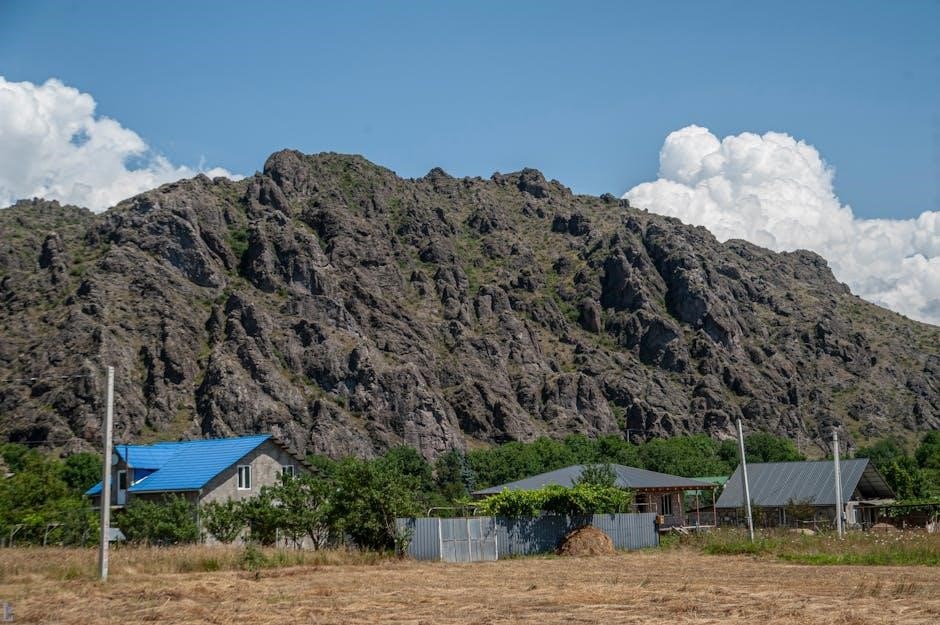
Conservation Efforts for Michigan Trees
Michigan actively protects its tree species through reforestation, combating invasive insects, and promoting sustainable practices to preserve biodiversity and ecosystem health for future generations.
Protecting Endangered Tree Species
Much attention is focused on safeguarding Michigan’s endangered tree species, such as the eastern hemlock and black ash, threatened by invasive pests and climate change. Conservation programs prioritize habitat restoration, seed banking, and controlled planting to ensure their survival. Collaborative efforts between state agencies, nonprofits, and researchers aim to protect these species’ genetic diversity. Public awareness campaigns highlight the importance of preserving these trees, while stricter regulations combat illegal logging and habitat destruction. Such measures are critical to maintaining Michigan’s ecological balance and biodiversity for future generations.
Sustainable Forestry Practices

Sustainable forestry practices in Michigan focus on balancing economic, environmental, and social needs. Techniques like selective logging and reforestation ensure forests remain healthy. Certification programs, such as the Forest Stewardship Council (FSC), promote responsible land use. These practices help preserve biodiversity, protect water quality, and maintain wildlife habitats. By adhering to sustainable methods, Michigan’s forests can continue to thrive, supporting both ecosystems and local communities for future generations.
Community Involvement in Tree Conservation
Community involvement is crucial for tree conservation in Michigan. Local organizations often host tree-planting events, workshops, and educational programs to engage residents. Volunteers participate in forest restoration projects, monitoring tree health, and combating invasive species. Public awareness campaigns emphasize the importance of trees in maintaining biodiversity and water quality. By fostering a sense of stewardship, communities can protect and enhance Michigan’s tree populations, ensuring their benefits are enjoyed for generations to come. Collaborative efforts between residents, schools, and conservation groups are key to successful tree conservation initiatives.
Additional Tips for Tree Enthusiasts
Explore local arboretums, participate in citizen science projects, and document tree observations in a personal journal to deepen knowledge and connection with Michigan’s tree species.
Creating a Personal Tree Identification Journal
Documenting your tree encounters in a personal journal enhances learning and appreciation. Include sketches, photos, and notes on leaf shapes, bark textures, and habitats. Record seasonal changes, like flowering or fall colors, to track species behaviors. Jot down personal insights or questions for further research. Use field guides or apps to verify IDs and add accurate names. Regular updates will help refine your observation skills. Over time, your journal becomes a valuable resource for recognizing Michigan’s diverse tree species and fostering a deeper connection with nature.
Joining Tree Identification Workshops
Engaging in tree identification workshops offers hands-on learning and expert guidance. These sessions often combine classroom instruction with field exploration, helping participants develop practical skills. Workshops cover topics like using field guides, identifying key features, and distinguishing similar species. Many programs are led by botanists, foresters, or experienced naturalists, providing valuable insights. Interactive activities and group discussions foster a collaborative environment. Whether you’re a novice or an advanced enthusiast, workshops enhance your ability to recognize Michigan’s tree species confidently. They also provide opportunities to connect with like-minded individuals and gain access to additional resources for continued learning.
Engaging with Local Botanical Gardens
Local botanical gardens provide a unique opportunity to explore Michigan’s tree species in a curated environment. These gardens often feature labeled specimens, allowing visitors to study tree characteristics up close. Interactive exhibits and guided tours enhance learning, while expert staff offer insights into identification and care. Many gardens host seasonal events, such as tree walks or pruning workshops, which cater to both beginners and enthusiasts. By engaging with these resources, you can deepen your understanding of Michigan’s native and cultivated trees, gaining hands-on experience in a beautiful and educational setting.
Glossary of Tree Identification Terms
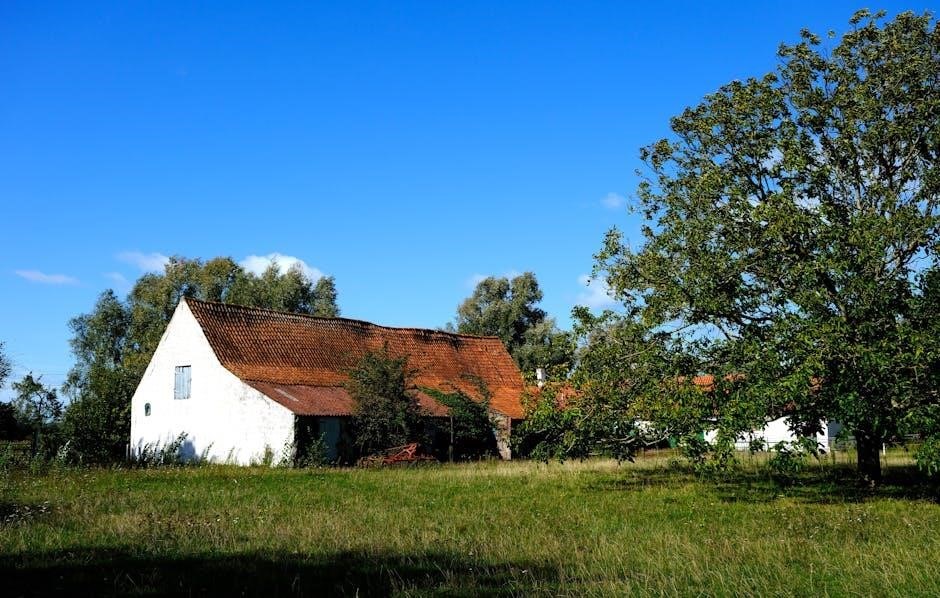
A collection of key terms essential for identifying Michigan’s trees, this glossary provides clear definitions to aid enthusiasts. Deciduous refers to trees that shed leaves annually, while coniferous describes those with needle-like foliage. Bark is the outer covering of the trunk, often unique to species. Leaf venation outlines the pattern of veins, and petiole is the stem attaching the leaf to the branch. Terms like ovate, alternate, and pinnate describe leaf shapes and arrangements. Understanding these terms enhances accurate tree identification and deepens appreciation for Michigan’s diverse tree species.

